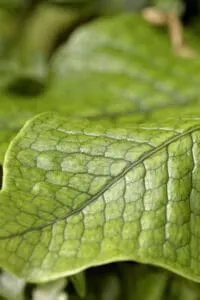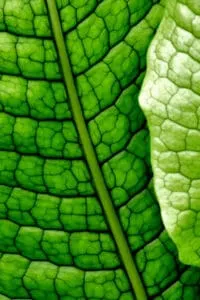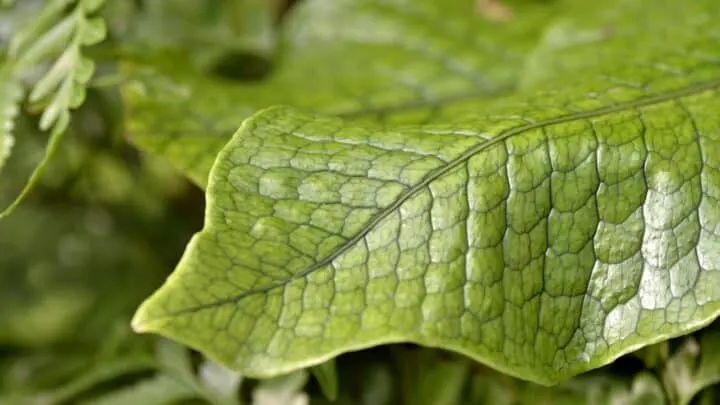There is a new plant in the market for fern lovers.
Coming from Australia and Southeast Asia, the Microsorum Crocodylus or Crocodile Fern has unique textured foliage.
Its botanical name is Microsorum musifolium Copel., according to Exotic Rainforest.
Despite being named after crocodiles, the fern’s leaves are delicate.
Each fern variety has its own unique look and care requirements, and no two ferns are alike.
Based on my growing experience with this fern variety, it classifies as a hardy plant.
This fern variety can also clean the air by absorbing harmful elements. The scientific name for this variety is Microsorum Musifolium.
This is a sensitive plant, so make sure you follow my Crocodile Fern Care guide in this article if you want to have a healthy growing Crocodile Fern.
Crocodile Fern Care
To care for a Crocodile fern use a soil mix consisting of sand, composted leaves, and charcoal chips. Water when 2” (5 cm) of topsoil are dry. Provide indirect bright light throughout the growing season and maintain a temperature between 64 to 73 degrees Fahrenheit (18 to 23 degrees Celsius). The ideal humidity level is >50 %. Fertilize once a month with a fern fertilizer.

Crocodile Fern Care
Table of Contents
Crocodile Fern Care Guide
Soil
African violet soil mixture is best suited for this fern a Crocodile Fern as this soil can retain moisture.
This is an epiphytic plant, so it thrives in a loose soil mixture.
You can use the following materials.
- One part charcoal chips
- Two parts composted leaves
- Two parts potting soil
- One part coarse sand
The sand and charcoal play a major role in ensuring drainage within the potting mixture.
The planter or pot should also have at least one drainage hole. This plant has a shallow root system to avoid planting in deep containers.
This is a tropical fern, so you can grow it outdoors if you live in USDA hardiness zones 10-11.
The pH of the soil for this fern should be between 6 and 8.5.
Water
Anyone growing ta Crocodile Fern would agree that it likes to drink water. So water it regularly when the top two inches are dry.
The water sitting on the leaves can result in mushy leaves, and this water will drip down and collect in the center.
If you are growing it epiphytically, the moisture is supplied via misting. Make sure you mist it daily in summer.
Soggy soil or poor drainage should be avoided as it can rot the rhizome for this plant.
Whenever you water this plant, make sure all the potting soil from top to bottom is saturated.
A useful tip is to keep adding water until you see it start dripping from the planter’s drainage hole.
You can reduce watering when the temperature starts dropping in autumn.
Light
A Crocodile Fern is forgiving in terms of light because it grows in low light. Any spot with indirect sunlight is best suited.
A small amount of morning sun is beneficial for the overall growth and leaf color.
If you notice pale or scorched leaves, it’s a sign that the fern‘s getting too much light.
Relocate it to another spot where it receives less bright light.
When growing it inside a vivarium, try using LED lights in cool shades.
This will create a shaded atmosphere inside the vivarium.
If you are a fan of sunlight, you can place the vivarium next to a window so that indirect sun rays fall on the Crocodile Fern.
Temperature
Crocodile Fern needs a temperature between 64 to 73 degrees Fahrenheit (18 to 23 degrees Celsius).
With regards to the lowest temperature, there are some restrictions.
This plant cannot handle temperatures lower than the 53 degrees Fahrenheit (12 degrees Celsius) mark.
The Crocodile Fern grows in USDA hardiness Zone s10-11 according to o Missouri Botanical Garden.
Humidity
The ideal humidity level for a Crocodile Fern is 50 % or above.
It’s simple to understand the humidity requirements of this plant.
It comes from the tropics, so it needs a tropical atmosphere.
I would recommend growing this plant in your bathroom or kitchen as this ensures high humidity at most times of the day.
Additionally, place some pebbles in the drainage tray and fill it with water.
This water will evaporate and automatically increase the humidity around the Crocodile Fern.
If your plant is still not satisfied with the humidity, you can go for a permanent solution and invest in a humidifier.
Mine has never had trouble with humidity since I have started using a humidifier that ensures 75% humidity day and night.

Crocodile Fern prefers a humidity of 50% and higher
Fertilizer
A regular dose of fertilizer once a month can keep the Crocodile Fern healthy and perked up.
You can opt for a liquid fertilizer or any plant food designed specifically for ferns.
Feeding will also eliminate any nutrient deficiencies in the soil.
Feeding should be continued throughout the spring and summer. But over-fertilization should be avoided as it will not help the plant in growing faster.
The only thing the extra fertilizer will do is kill the plant or roots.
One major symptom of over-fertilization is tip burn or browning.
Repotting
The Crocodile Fern is not a fast-growing fern, so it should be repotted only when the pot is too small for it.
Repot it in spring while following these steps.
- Gently remove the crocodile fern from its pot. And thoroughly inspect the root system.
- If you find any infected or dying roots, trim them immediately. Repotting allows you to check your plant for any signs of root rot. Do not damage any healthy roots while doing this.
- The last step is finally placing your plant in a new planter and pouring soil over it. Gently pat the soil with your hands or garden spatula to settle the soil.
As the root system is shallow, deep planting should be avoided.
Pruning
Most growers place the Crocodile Fern in a hanging basket or a plant stand to fully enjoy the view of the leaves.
This plant needs lots of space to grow, so if you want to keep it in a small compact look, prune it regularly.
Pruning dead fronds will signal the plant to grow new leaves. Pruning also saves the energy wasted in reviving the damaged foliage.
Propagation
You can propagate a Crocodile Fern by division.
Ferns grow from spores instead of seeds.
You can add more ferns to your collection by the division method.
Separate the rhizome gently without causing any damage to the foliage or root system.
Any root damage in this process can shock the original fern.
Take these divided sections and plant them in a moist soil medium.
Choose a mixture that is rich in nutrients and organic content. You can follow the recipe I have shared in the soil section.
Regularly water the new ferns but make sure they are never sitting in water.
These new ferns are highly susceptible to transplant shock. You do not want to overwater and make the situation worst.

Crocodile Ferns can be propagated by division
Blooms
This Crocodile Fern does produce any noteworthy blooms.
All the praise is for the leaves.
Growth
A mature Crocodile Fern measures 2 – 5 ft (0.6-1.5 m) in width and height.
The pucker, wrinkled leaves are the secret to the popularity of this fern.
These leaves themselves are light green, but the veins on them are dark green. The pattern on the leaves resembles crocodile skin.
The spear-shaped leaves can grow up to 2 ft long, and all of them grow in a rosette structure.
The leaves will pop out directly from the rhizomes or the rhizoids. These rhizoids also assist the Crocodile Fern in attaching itself to different surfaces.
The air purifying properties of this fern is another positive aspect of growing this plant.
Common Problems for Crocodile Fern
Overwatering
An overwatered Crocodile Fern will have a mushy and black center which indicates rhizome rot.
This fern grows in a rosette form, so the water can easily accumulate in the middle. The soil will remain soggy for a long period which has devastating effects.
Avoid this scenario by watering the plant as soon as you ascertain the soil’s dried out. Also, make sure water is not pooling at a single point.
Bacteria Blight
Blight on ferns is usually caused by the Pseudomonas cichorii or P. gladioli.
It begins as transparent spots on the fronds that eventually go reddish brown. These spots also have purple centers.
Always inspect the plant thoroughly before buying because this bacteria usually comes with newly bought plants.
Avoid watering the fern from above, but if the blight keeps spreading, discard the entire plant.
Pests
Mealybugs and Fern scale insects can sometimes infect this plant if the growing conditions are incorrect.
The scales will look like tiny white dots or disks on the textured leaves.
Rub some insecticidal soap on the leaves to get rid of the Fern scales and mealy bugs.
In my opinion, the best protection against bugs is prevention.
Practice good gardening hygiene and check your ferns and other houseplants for insect damage every week.
Tips for Growing Crocodile Fern
- Frost and chilly temperatures can kill this fern, so never leave it outside in such weather.
- This plant should not be kept too close to a sunny window as high light exposure can burn the foliage.
- Misting this fern variety every other day is a must.
- Make sure it has plenty of space for growth; otherwise, it will struggle to reach the maximum size.
- Root damage while repotting or rhizome division can kill the mother plant, or the new plant might not root at all.
- Make sure your potting mixture and pot both drain well. You can add perlite with peat moss to loosen the mixture for drainage and airflow.
- You should perform repotting if the plant is top-heavy or the root system is tangled within the pot.
- If you notice dust on the leaves, wipe them with a damp towel or fabric.
- The best way to find the perfect lighting for the Crocodile Fern is by moving it around in the house and seeing how it reacts to different light levels.
- If your plant has a wilted look, it will benefit from watering because lack of water can cause the leaves to wilt.
- If the temperature is less than 55 degrees Fahrenheit (12.7 degrees Celsius), the leaves will start discoloring and eventually die due to cold damage.
- If you are struggling with soil, simply use a mixture that’s peat-based and combine it with perlite.
Frequently Asked Questions About Crocodile Fern Care
Can a Crocodile Fern handle direct sunlight?
Crocodile fern is an understory plant from the humid jungles, so it’s not accustomed to direct sunlight. You can install blinds or sheer curtains to minimize the intensity of sunlight falling on this plant.
What do brown patches and crispy edges indicate on a Crocodile Fern?
The combination of brown patches and crispy edges means one thing; low humidity. Never let the Crocodile Fern dry out completely. You can mist the leaves and use the pebble tray method to keep the atmosphere moist.
What happens if Crocodile Fern is overwatered?
The lush green leaves will start yellowing very rapidly if the soil is left soggy for too long, and the rhizome will start rotting. If this happens, you can reevaluate the watering schedule and improve drainage.
What should I do in case I have overfed the Crocodile Fern?
Overfertilization is detrimental for any houseplant, including the Crocodile Fern. Take the pot to an open area and leach the soil to make sure all the fertilizer is washed away. Do not feed your plant for the next few days or weeks.
Is Crocodile Fern a heavy feeder?
The Crocodile Fern is not a heavy feeder so feeding it once a month is enough.
Can I place the Crocodile Fern in a vivarium?
It’s a good choice for a vivarium as it is pet-friendly. But make sure you maintain 75% humidity inside the vivarium. You can place it in a terrarium or a paludarium.
Why is pruning necessary for the Crocodile Fern?
If your plant is crowded and constantly kept in a moist, humid environment, there is a high risk of fungal infection. Regular pruning of the Crocodile Fern will help in preventing this situation as it increases airflow, and you get rid of diseased foliage.
Conclusion About Crocodile Fern Care
The puckering, wrinkles, leaf veins, wavy edges all add grace to this houseplant.
Crocodile Fern makes a statement even when it’s young, and it’s great for your bathroom or kitchen.
You can even decorate the vivarium with this plant.
When growing houseplants like Crocodile Fern just remember that the native habitat is damp with lots of humidity.

Daniel has been a plant enthusiast for over 20 years. He owns hundreds of houseplants and prepares for the chili growing seasons yearly with great anticipation. His favorite plants are plant species in the Araceae family, such as Monstera, Philodendron, and Anthurium. He also loves gardening and is growing hot peppers, tomatoes, and many more vegetables.


